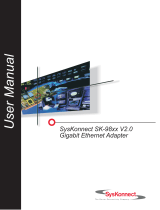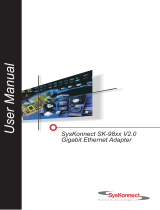
10. Press Enter. The system finds and highlights this device driver software.
11. Press F7 to select the highlighted device driver software.
12. Press Enter.
13. The INSTALL ADDITIONAL DEVICE SOFTWARE screen displays. The entry fields
are automatically updated. Press Enter to accept the information.
14. The ARE YOU SURE window displays. Press Enter to accept the information.
15. The COMMAND STATUS screen displays.
v The term RUNNING is highlighted to indicate that the installation and configuration
command is in progress.
v When RUNNING changes to OK, scroll to the bottom of the page and locate the
Installation Summary.
v After a successful installation, SUCCESS displays in the Result column of the
Installation Summary at the bottom of the page.
16. Remove the installation media from the drive.
17. Press F10 to exit SMIT.
18. Go to the adapter installation procedure, Chapter 4, “Installing the 10/100/1000
Base-TX Ethernet PCI-X Adapter” on page 9.
Verify AIX Software Installation
To verify that the device driver for the 10/100/1000 Base-TX Ethernet PCI-X Adapter is
installed, do the following:
1. If necessary, log in as root user.
2. At the command line, type:
lslpp -1 devices.pci.14106902.rte
3. Press Enter.
Possible results are as follows:
v If the 10/100/1000 Base-TX Ethernet PCI-X Adapter device driver is installed, the
following is an example of the data that displays on your screen:
Fileset Level State Description
-----------------------------------------------------------------------
Path: /usr/lib/objrepos
devices.pci.14106902.rte 5.1.35 COMMITTED ...Ethernet...
Adapter Software
Path: /etc/objrepos
devices.pci.14106902.rte 5.1.35 COMMITTED ...Ethernet...
Adapter Software
Verify that the filesets devices.pci.14106902.rte are installed at the AIX 5.1.35 or
later level.
If this information displays but you continue to have problems, go to Chapter 4,
“Installing the 10/100/1000 Base-TX Ethernet PCI-X Adapter” on page 9.
v If no data displays on your screen, the 10/100/1000 Base-TX Ethernet PCI-X
Adapter device driver did not install correctly. Return to Chapter 3, “Installing the
6 10/100/1000 Base-TX Ethernet PCI-X Adapter Installation and Using Guide





















